Simulation of LUCC Dynamics and Estimation of Carbon Stock under Different SSP-RCP Scenarios in Heilongjiang Province
Abstract
:1. Introduction
2. Materials and Methods
2.1. Study Area and Data Source
2.2. Methodologies
2.2.1. Defining Future Climate Scenarios
2.2.2. Land Use Demand Projection Using SD Model
2.2.3. Future LUCC Simulation Using PLUS Model
2.2.4. Carbon Stock Estimation Using InVEST Model
3. Results
3.1. Future Land Use Demand Projection Using SD Model
3.2. Simulation of Future Land Use Distribution
3.3. Prediction of Future Carbon Stock Based on the Invest Model
4. Discussion
4.1. Land Use Simulation Based on SD-PLUS Model
4.2. Changes in Carbon Stock and Its Response to LUCC
4.3. Limitations and Implications
5. Conclusions
Author Contributions
Funding
Data Availability Statement
Acknowledgments
Conflicts of Interest
References
- Zhu, G.F.; Qiu, D.D.; Zhang, Z.A.X.; Sang, L.Y.; Liu, Y.W.; Wang, L.; Zhao, K.L.; Ma, H.Y.; Xu, Y.; Wan, Q. Land-use changes lead to a decrease in carbon storage in arid region, China. Ecol. Indic. 2021, 127, 10. [Google Scholar] [CrossRef]
- Tarpeh, W.A.; Chen, X. Making wastewater obsolete: Selective separations to enable circular water treatment. Environ. Sci. Ecotechnol. 2021, 5, 8. [Google Scholar] [CrossRef] [PubMed]
- Ito, A.; Nishina, K.; Noda, H.M. Impacts of future climate change on the carbon budget of northern high-latitude terrestrial ecosystems: An analysis using ISI-MIP data. Polar Sci. 2016, 10, 346–355. [Google Scholar] [CrossRef]
- Schimel, D.S.; House, J.I.; Hibbard, K.A.; Bousquet, P.; Ciais, P.; Peylin, P.; Braswell, B.H.; Apps, M.J.; Baker, D.; Bondeau, A.; et al. Recent patterns and mechanisms of carbon exchange by terrestrial ecosystems. Nature 2001, 414, 169–172. [Google Scholar] [CrossRef] [PubMed]
- Houghton, R.A.; Hackler, J.L.; Lawrence, K.T. The U.S. Carbon budget: Contributions from land-Use change. Science 1999, 285, 574–578. [Google Scholar] [CrossRef] [PubMed]
- Chuai, X.W.; Huang, X.J.; Wang, W.J.; Zhang, M.; Lai, L.; Liao, Q.L. Spatial Variability of Soil Organic Carbon and Related Factors in Jiangsu Province, China. Pedosphere 2012, 22, 404–414. [Google Scholar] [CrossRef]
- Houghton, R.J. Magnitude, distribution and causes of terrestrial carbon sinks and some implications for policy. Clim. Policy 2002, 2, 71–88. [Google Scholar] [CrossRef]
- Arneth, A.; Sitch, S.; Pongratz, J.; Stocker, B.D.; Ciais, P.; Poulter, B.; Bayer, A.D.; Bondeau, A.; Calle, L.; Chini, L.P.; et al. Historical carbon dioxide emissions caused by land-use changes are possibly larger than assumed. Nat. Geosci. 2017, 10, 79–84. [Google Scholar] [CrossRef]
- Chen, Y.X.; Huang, B.Y.; Zeng, H. How does urbanization affect vegetation productivity in the coastal cities of eastern China? Sci. Total Environ. 2022, 811, 10. [Google Scholar] [CrossRef]
- Feddema, J.J.; Oleson, K.W.; Bonan, G.B.; Mearns, L.O.; Buja, L.E.; Meehl, G.A.; Washington, W.M. The importance of land-cover change in simulating future climates. Science 2005, 310, 1674–1678. [Google Scholar] [CrossRef]
- Mendoza-Ponce, A.; Corona-Nunez, R.; Kraxner, F.; Leduc, S.; Patrizio, P. Identifying effects of land use cover changes and climate change on terrestrial ecosystems and carbon stocks in Mexico. Glob. Environ. Change Hum. Policy Dimens. 2018, 53, 12–23. [Google Scholar] [CrossRef]
- Marland, G.; Rotty, R.; Treat, N.J. CO2 from fossil fuel burning: Global distribution of emissions. Tellus B 1985, 37, 243–258. [Google Scholar] [CrossRef]
- Le Page, Y.; West, T.O.; Link, R.; Patel, P. Downscaling land use and land cover from the Global Change Assessment Model for coupling with Earth system models. Geosci. Model Dev. 2016, 9, 3055–3069. [Google Scholar] [CrossRef]
- Thomson, A.M.; Kyle, G.P.; Zhang, X.; Bandaru, V.; West, T.O.; Wise, M.A.; Izaurralde, R.C.; Calvin, K.V. The contribution of future agricultural trends in the US Midwest to global climate change mitigation. Glob. Environ. Change Hum. Policy Dimens. 2014, 24, 143–154. [Google Scholar] [CrossRef]
- Calle, L.; Canadell, J.G.; Patra, P.; Ciais, P.; Ichii, K.; Tian, H.Q.; Kondo, M.; Piao, S.L.; Arneth, A.; Harper, A.B.; et al. Regional carbon fluxes from land use and land cover change in Asia, 1980–2009. Environ. Res. Lett. 2016, 11, 12. [Google Scholar] [CrossRef]
- Vasenev, V.I.; Stoorvogel, J.J.; Leemans, R.; Valentini, R.; Hajiaghayeva, R.A. Projection of urban expansion and related changes in soil carbon stocks in the Moscow Region. J. Clean. Prod. 2018, 170, 902–914. [Google Scholar] [CrossRef]
- Zhou, J.J.; Zhao, Y.R.; Huang, P.; Zhao, X.; Feng, W.; Li, Q.Q.; Xue, D.X.; Dou, J.; Shi, W.; Wei, W.; et al. Impacts of ecological restoration projects on the ecosystem carbon storage of inland river basin in arid area, China. Ecol. Indic. 2020, 118, 13. [Google Scholar] [CrossRef]
- Newbold, T.; Hudson, L.N.; Hill, S.L.L.; Contu, S.; Lysenko, I.; Senior, R.A.; Borger, L.; Bennett, D.J.; Choimes, A.; Collen, B.; et al. Global effects of land use on local terrestrial biodiversity. Nature 2015, 520, 45–50. [Google Scholar] [CrossRef]
- Feng, Y.J.; Chen, S.R.; Tong, X.H.; Lei, Z.K.; Gao, C.; Wang, J.F. Modeling changes in China’s 2000–2030 carbon stock caused by land use change. J. Clean. Prod. 2020, 252, 12. [Google Scholar] [CrossRef]
- Fan, Z. Simulation of land cover change in Beijing-Tianjin-Hebei region under different SSP-RCP scenarios. Acta Geogr. Sin. 2022, 77, 228–244. [Google Scholar]
- Kumar, S.; Radhakrishnan, N.; Mathew, S. Land use change modelling using a Markov model and remote sensing. Geomat. Nat. Hazards Risk 2014, 5, 145–156. [Google Scholar] [CrossRef]
- Pijanowski, B.C.; Brown, D.G.; Shellito, B.A.; Manik, G.A.J. Using neural networks and GIS to forecast land use changes: A land transformation model. Comput. Environ. Urban Syst. 2002, 26, 553–575. [Google Scholar] [CrossRef]
- Subedi, P.; Subedi, K.; Thapa, B.J. Application of a hybrid cellular automaton–Markov (CA-Markov) model in land-use change prediction: A case study of Saddle Creek Drainage Basin, Florida. Appl. Ecol. Environ. Sci. 2013, 1, 126–132. [Google Scholar] [CrossRef]
- Liu, X.P.; Liang, X.; Li, X.; Xu, X.C.; Ou, J.P.; Chen, Y.M.; Li, S.Y.; Wang, S.J.; Pei, F. A future land use simulation model (FLUS) for simulating multiple land use scenarios by coupling human and natural effects. Landsc. Urban Plan. 2017, 168, 94–116. [Google Scholar] [CrossRef]
- Kok, K.; Winograd, M.J. Modelling land-use change for Central America, with special reference to the impact of hurricane Mitch. Ecol. Model. 2002, 149, 53–69. [Google Scholar] [CrossRef]
- Hu, X.T.; Li, Z.H.; Cai, Y.M.; Wu, F. Urban construction land demand prediction and spatial pattern simulation under carbon peak and neutrality goals: A case study of Guangzhou, China. J. Geogr. Sci. 2022, 32, 2251–2270. [Google Scholar] [CrossRef]
- Karimi, H.; Jafarnezhad, J.; Khaledi, J.; Ahmadi, P. Monitoring and prediction of land use/land cover changes using CA-Markov model: A case study of Ravansar County in Iran. Arab. J. Geosci. 2018, 11, 9. [Google Scholar] [CrossRef]
- Verburg, P.; Overmars, K.J. Dynamic simulation of land-use change trajectories with the CLUE-s model. Model. Land-Use Change Prog. Appl. 2007, 90, 321–337. [Google Scholar]
- Liang, X.; Liu, X.P.; Li, X.; Chen, Y.M.; Tian, H.; Yao, Y. Delineating multi-scenario urban growth boundaries with a CA-based FLUS model and morphological method. Landsc. Urban Plan. 2018, 177, 47–63. [Google Scholar] [CrossRef]
- Sohl, T.L.; Claggett, P.R. Clarity versus complexity: Land-use modeling as a practical tool for decision-makers. J. Environ. Manag. 2013, 129, 235–243. [Google Scholar] [CrossRef]
- Liang, X.; Guan, Q.F.; Clarke, K.C.; Liu, S.S.; Wang, B.Y.; Yao, Y. Understanding the drivers of sustainable land expansion using a patch-generating land use simulation (PLUS) model: A case study in Wuhan, China. Comput. Environ. Urban Syst. 2021, 85, 14. [Google Scholar] [CrossRef]
- Gao, L.A.; Tao, F.; Liu, R.R.; Wang, Z.L.; Leng, H.J.; Zhou, T. Multi-scenario simulation and ecological risk analysis of land use based on the PLUS model: A case study of Nanjing. Sustain. Cities Soc. 2022, 85, 11. [Google Scholar] [CrossRef]
- Mahiny, A.S.; Clarke, K.C. Guiding SLEUTH land-use/land-cover change modeling using multicriteria evaluation: Towards dynamic sustainable land-use planning. Environ. Plan. B Plan. Des. 2012, 39, 925–944. [Google Scholar] [CrossRef]
- Tan, J.B.; Li, A.N.; Lei, G.B.; Xie, X.Y. A SD-MaxEnt-CA model for simulating the landscape dynamic of natural ecosystem by considering socio-economic and natural impacts. Ecol. Model. 2019, 410, 11. [Google Scholar] [CrossRef]
- Wu, M.; Ren, X.Y.; Che, Y.; Yang, K. A Coupled SD and CLUE-S Model for Exploring the Impact of Land Use Change on Ecosystem Service Value: A Case Study in Baoshan District, Shanghai, China. Environ. Manag. 2015, 56, 402–419. [Google Scholar] [CrossRef] [PubMed]
- Oliver, T.H.; Morecroft, M.D. Interactions between climate change and land use change on biodiversity: Attribution problems, risks, and opportunities. Wiley Interdiscip. Rev. Clim. Chang. 2014, 5, 317–335. [Google Scholar] [CrossRef]
- Bussi, G.; Janes, V.; Whitehead, P.G.; Dadson, S.J.; Holman, I.P. Dynamic response of land use and river nutrient concentration to long-term climatic changes. Sci. Total Environ. 2017, 590, 818–831. [Google Scholar] [CrossRef]
- Yang, H.; Huang, J.L.; Liu, D.F. Linking climate change and socioeconomic development to urban land use simulation: Analysis of their concurrent effects on carbon storage. Appl. Geogr. 2020, 115, 12. [Google Scholar] [CrossRef]
- Eyring, V.; Bony, S.; Meehl, G.A.; Senior, C.A.; Stevens, B.; Stouffer, R.J.; Taylor, K.E. Overview of the Coupled Model Intercomparison Project Phase 6 (CMIP6) experimental design and organization. Geosci. Model Dev. 2016, 9, 1937–1958. [Google Scholar] [CrossRef]
- Li, J.Y.; Chen, X.; Kurban, A.; Van de Voorde, T.; De Maeyer, P.; Zhang, C. Coupled SSPs-RCPs scenarios to project the future dynamic variations of water-soil-carbon-biodiversity services in Central Asia. Ecol. Indic. 2021, 129, 15. [Google Scholar] [CrossRef]
- Gao, Y. China’s response to climate change issues after Paris Climate Change Conference. Adv. Clim. Chang. Res. 2016, 7, 235–240. [Google Scholar] [CrossRef]
- Ge, Q.S.; Dai, J.H.; He, F.N.; Pan, Y.; Wang, M.M. Land use changes and their relations with carbon cycles over the past 300 a in China. Sci. China Ser. D Earth Sci. 2008, 51, 871–884. [Google Scholar] [CrossRef]
- Liao, W.L.; Liu, X.P.; Xu, X.Y.; Chen, G.Z.; Liang, X.; Zhang, H.H.; Li, X. Projections of land use changes under the plant functional type classification in different SSP-RCP scenarios in China. Sci. Bull. 2020, 65, 1935–1947. [Google Scholar] [CrossRef] [PubMed]
- Liu, H.; Liu, Y.X.; Wang, C.X.; Zhao, W.W.; Liu, S.L. Landscape pattern change simulations in Tibet based on the combination of the SSP-RCP scenarios. J. Environ. Manag. 2021, 292, 15. [Google Scholar] [CrossRef] [PubMed]
- Fang, J.Y.; Yu, G.R.; Liu, L.L.; Hu, S.J.; Chapin, F.S. Climate change, human impacts, and carbon sequestration in China. Proc. Natl. Acad. Sci. USA 2018, 115, 4015–4020. [Google Scholar] [CrossRef] [PubMed]
- Dong, N.; You, L.; Cai, W.J.; Li, G.; Lin, H. Land use projections in China under global socioeconomic and emission scenarios: Utilizing a scenario-based land-use change assessment framework. Glob. Environ. Change Hum. Policy Dimens. 2018, 50, 164–177. [Google Scholar] [CrossRef]
- Yun, X.B.; Tang, Q.H.; Li, J.B.; Lu, H.; Zhang, L.; Chen, D.L. Can reservoir regulation mitigate future climate change induced hydrological extremes in the Lancang-Mekong River Basin? Sci. Total Environ. 2021, 785, 9. [Google Scholar] [CrossRef]
- Wang, Z.Y.; Li, X.; Mao, Y.T.; Li, L.; Wang, X.R.; Lin, Q. Dynamic simulation of land use change and assessment of carbon storage based on climate change scenarios at the city level: A case study of Bortala, China. Ecol. Indic. 2022, 134, 11. [Google Scholar] [CrossRef]
- Liu, J.L.; Peng, K.L.; Zuo, C.C.; Li, Q. Spatiotemporal variation of land-use carbon emissions and its implications for low carbon and ecological civilization strategies: Evidence from Xiamen-Zhangzhou-Quanzhou metropolitan circle, China. Sustain. Cities Soc. 2022, 86, 13. [Google Scholar] [CrossRef]
- Yen, G.; Li, X. A constrained CA model for the simulation and planning of sustainable urban forms by using GIS. Environ. Plan. B Plan. Des. 2001, 28, 733–753. [Google Scholar]
- Sante, I.; Garcia, A.M.; Miranda, D.; Crecente, R. Cellular automata models for the simulation of real-world urban processes: A review and analysis. Landsc. Urban Plan. 2010, 96, 108–122. [Google Scholar] [CrossRef]
- Fu, X.; Wang, X.H.; Yang, Y.J. Deriving suitability factors for CA-Markov land use simulation model based on local historical data. J. Environ. Manag. 2018, 206, 10–19. [Google Scholar] [CrossRef] [PubMed]
- Zhang, Z.; Li, J.M. Spatial suitability and multi-scenarios for land use: Simulation and policy insights from the production-living-ecological perspective. Land Use Pol. 2022, 119, 13. [Google Scholar] [CrossRef]
- Jiang, X.; Duan, H.; Liao, J.; Song, X.; Xue, X. Land use in the Gan-Lin-Gao region of middle reaches of Heihe River Basin based on a PLUS-SD coupling model. Arid Zone Res. 2022, 39, 1246–1258. [Google Scholar]
- Yu, Y.; Guo, B.; Wang, C.L.; Zang, W.Q.; Huang, X.Z.; Wu, Z.W.; Xu, M.; Zhou, K.D.; Li, J.; Yang, Y. Carbon storage simulation and analysis in Beijing-Tianjin-Hebei region based on CA-plus model under dual-carbon background. Geomat. Nat. Hazards Risk 2023, 14, 24. [Google Scholar] [CrossRef]
- Wang, X.; Che, L.; Zhou, L.; Xu, J.G. Spatio-temporal Dynamic Simulation of Land use and Ecological Risk in the Yangtze River Delta Urban Agglomeration, China. Chin. Geogr. Sci. 2021, 31, 829–847. [Google Scholar] [CrossRef]
- Wang, Y.H.; Dai, E.F.; Yin, L.; Ma, L. Land use/land cover change and the effects on ecosystem services in the Hengduan Mountain region, China. Ecosyst. Serv. 2018, 34, 55–67. [Google Scholar] [CrossRef]
- Wu, M.W.; Wu, J.Q.; Zang, C.F. A comprehensive evaluation of the eco-carrying capacity and green economy in the Guangdong-Hong Kong-Macao Greater Bay Area, China. J. Clean. Prod. 2021, 281, 16. [Google Scholar] [CrossRef]
- Rees, R.M.; Bingham, I.J.; Baddeley, J.A.; Watson, C.A. The role of plants and land management in sequestering soil carbon in temperate arable and grassland ecosystems. Geoderma 2005, 128, 130–154. [Google Scholar] [CrossRef]
- Wang, C.L.; Jiang, Q.O.; Shao, Y.Q.; Sun, S.Y.; Xiao, L.; Guo, J.B. Ecological environment assessment based on land use simulation: A case study in the Heihe River Basin. Sci. Total Environ. 2019, 697, 14. [Google Scholar] [CrossRef]
- Li, Y.R.; Li, Y.; Fan, P.C.; Long, H.L. Impacts of land consolidation on rural human-environment system in typical watershed of the Loess Plateau and implications for rural development policy. Land Use Pol. 2019, 86, 339–350. [Google Scholar]
- Liu, G.; Zhang, F. Land Zoning Management to Achieve Carbon Neutrality: A Case Study of the Beijing–Tianjin–Hebei Urban Agglomeration, China. Land 2022, 11, 551. [Google Scholar] [CrossRef]
- Li, S.Y.; Miao, L.J.; Jiang, Z.H.; Wang, G.J.; Gnyawali, K.R.; Zhang, J.; Zhang, H.; Fang, K.; He, Y.; Li, C. Projected drought conditions in Northwest China with CMIP6 models under combined SSPs and RCPs for 2015–2099. Adv. Clim. Chang. Res. 2020, 11, 210–217. [Google Scholar] [CrossRef]
- Flannigan, M.; Stocks, B.; Turetsky, M.; Wotton, M. Impacts of climate change on fire activity and fire management in the circumboreal forest. Glob. Chang. Biol. 2009, 15, 549–560. [Google Scholar] [CrossRef]
- Bai, Y.F.; Cotrufo, M.F. Grassland soil carbon sequestration: Current understanding, challenges, and solutions. Science 2022, 377, 603–608. [Google Scholar] [CrossRef] [PubMed]
- Chaplin-Kramer, R.; Sharp, R.P.; Mandle, L.; Sim, S.; Johnson, J.; Butnar, I.; Canals, L.M.I.; Eichelberger, B.A.; Ramler, I.; Mueller, C.; et al. Spatial patterns of agricultural expansion determine impacts on biodiversity and carbon storage. Proc. Natl. Acad. Sci. USA 2015, 112, 7402–7407. [Google Scholar] [CrossRef] [PubMed]
- Zhang, Y.; Shi, X.; Tang, Q. Carbon storage assessment in the upper reaches of the Fenhe River under different land use scenarios. Acta Ecol. Sin. 2021, 41, 360–373. [Google Scholar]
- Yu, P.J.; Li, Q.; Jia, H.T.; Li, G.D.; Zheng, W.; Shen, X.J.; Diabate, B.; Zhou, D.W. Effect of Cultivation on Dynamics of Organic and Inorganic Carbon Stocks in Songnen Plain. Agron. J. 2014, 106, 1574–1582. [Google Scholar] [CrossRef]
- Cihacek, L.; Ulmer, M. Effects of tillage on inorganic carbon storage in soils of the northern Great Plains of the US. In Agricultural Practices and Policies for Carbon Sequestration in Soil; CRC Press: Boca Raton, FL, USA, 2016; pp. 87–94. [Google Scholar]
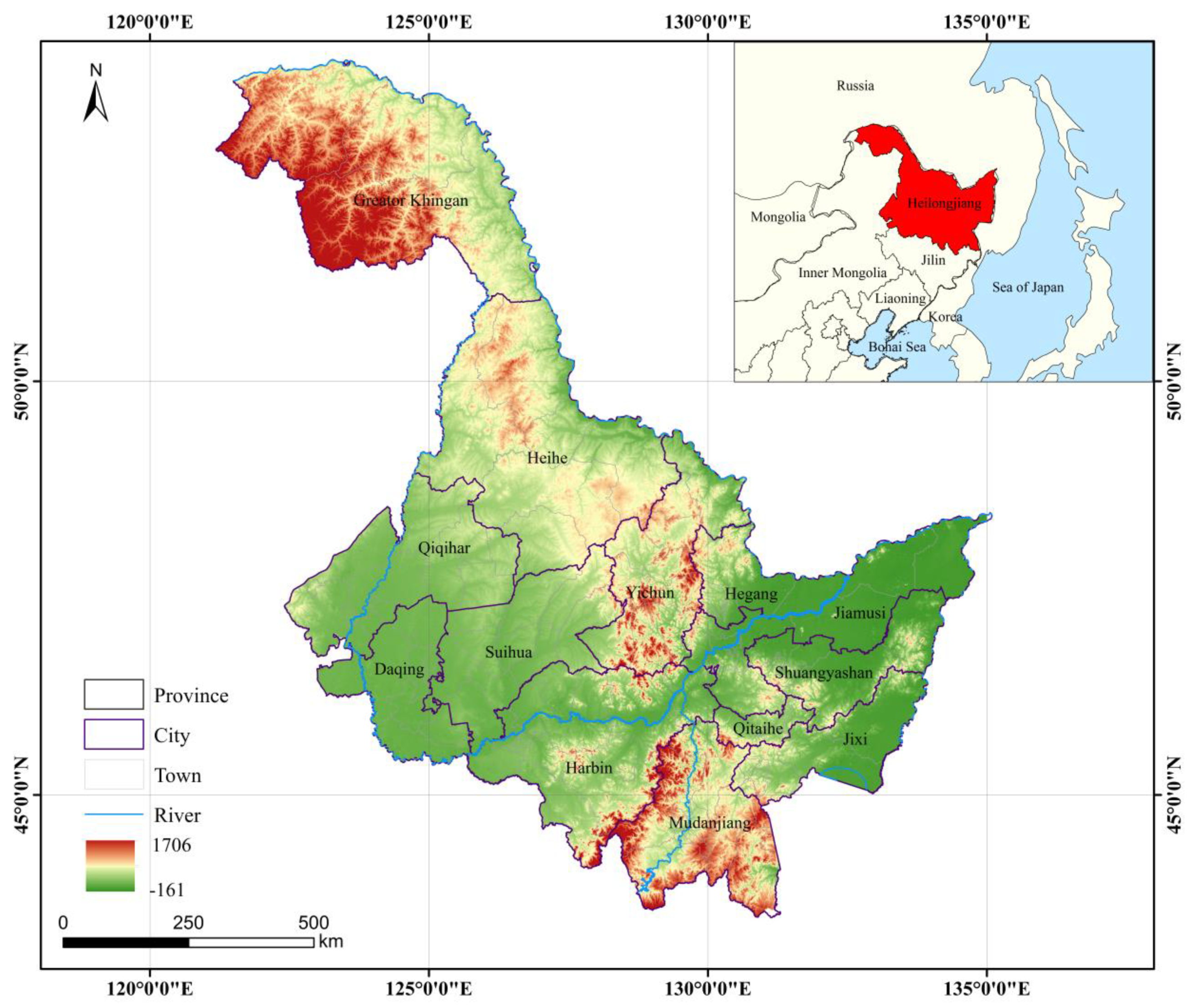
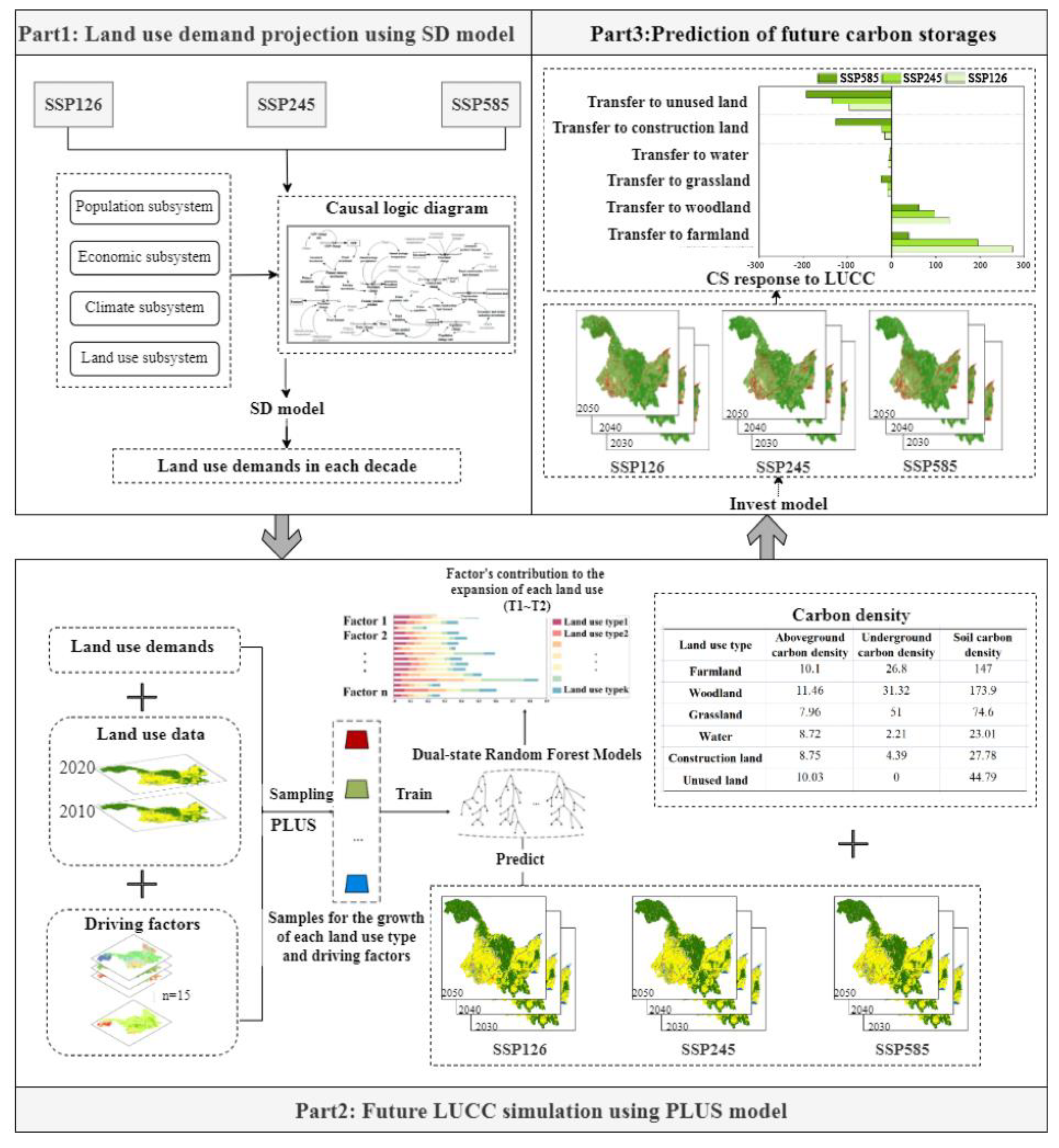
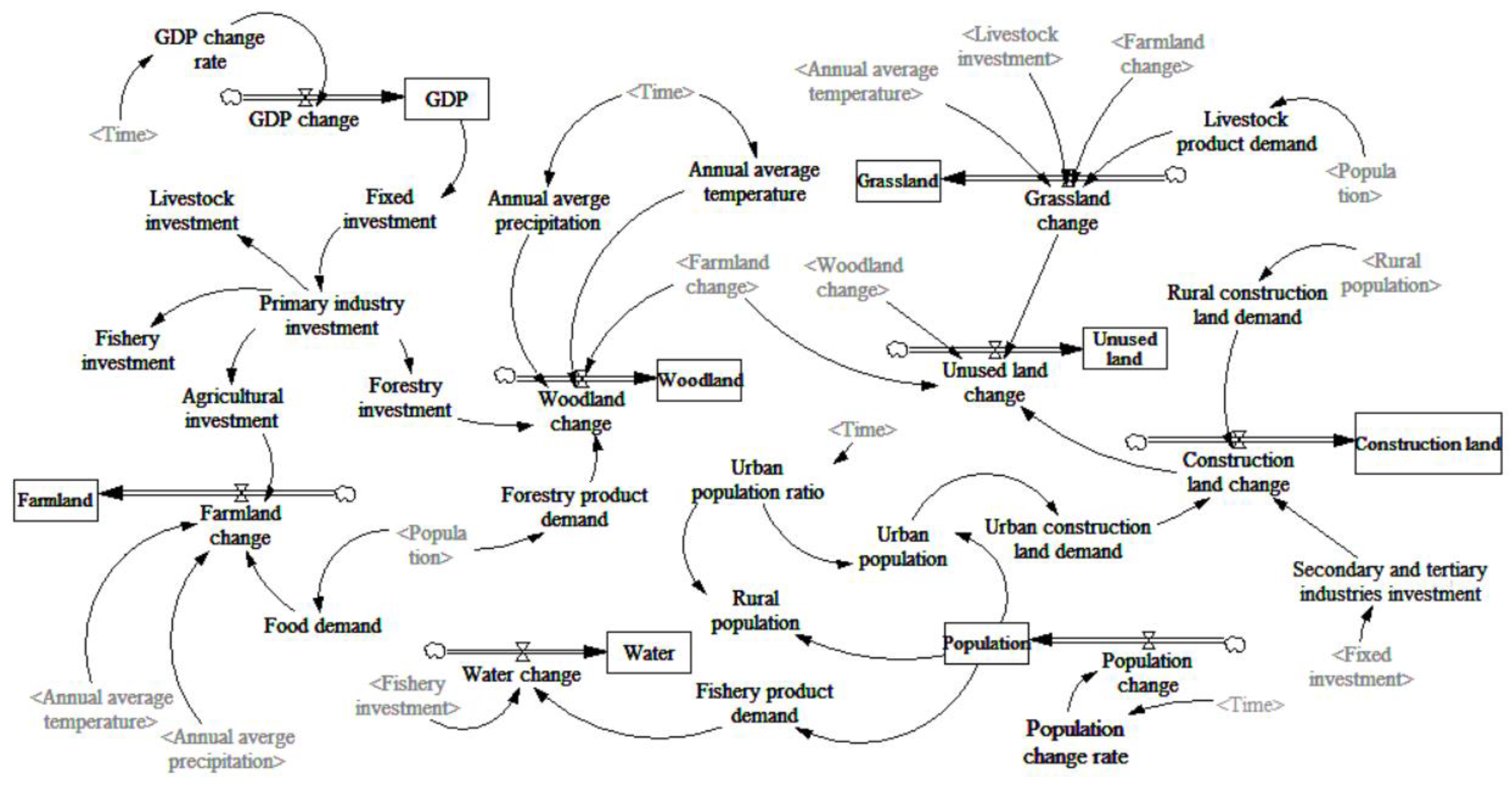


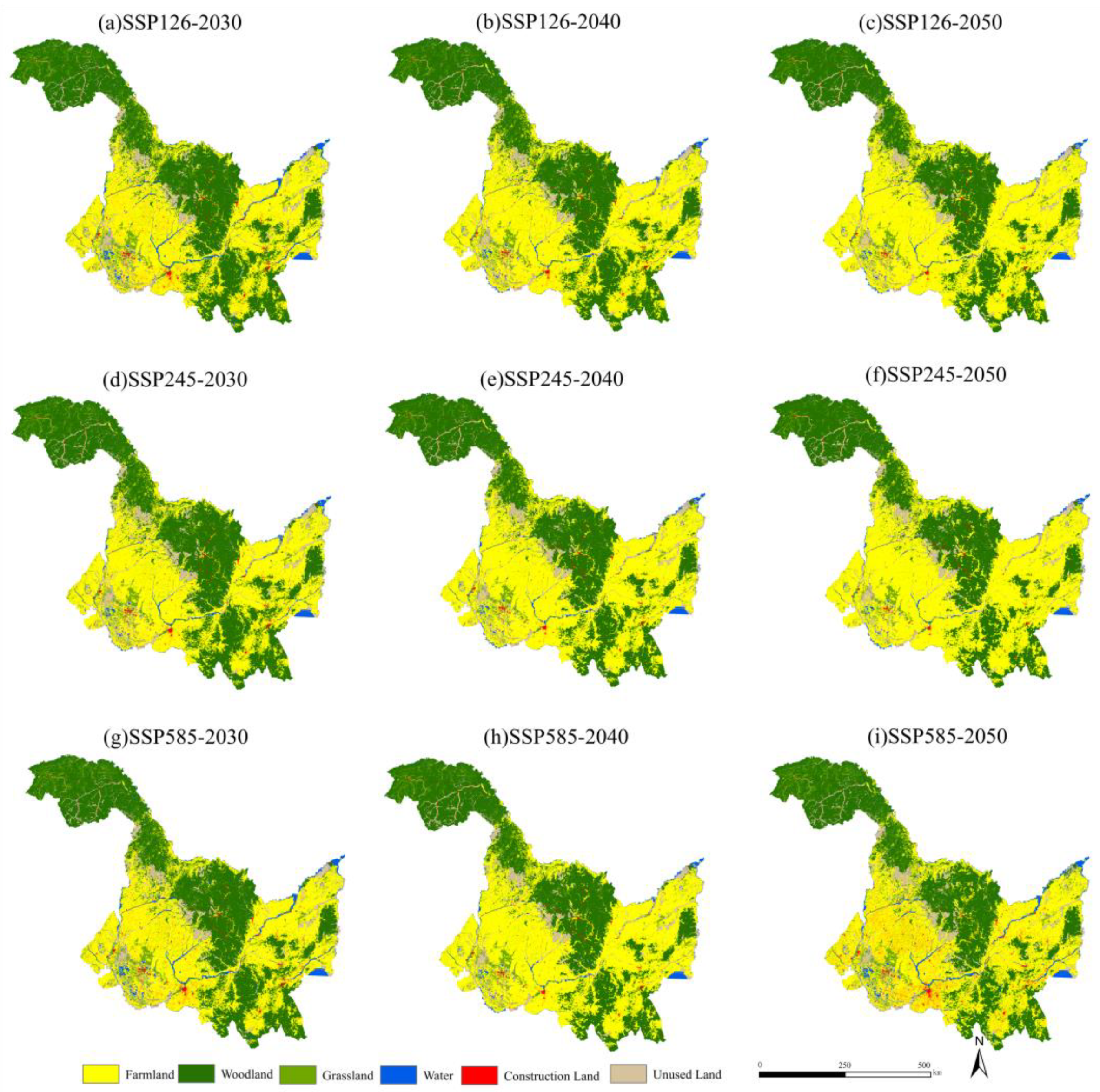
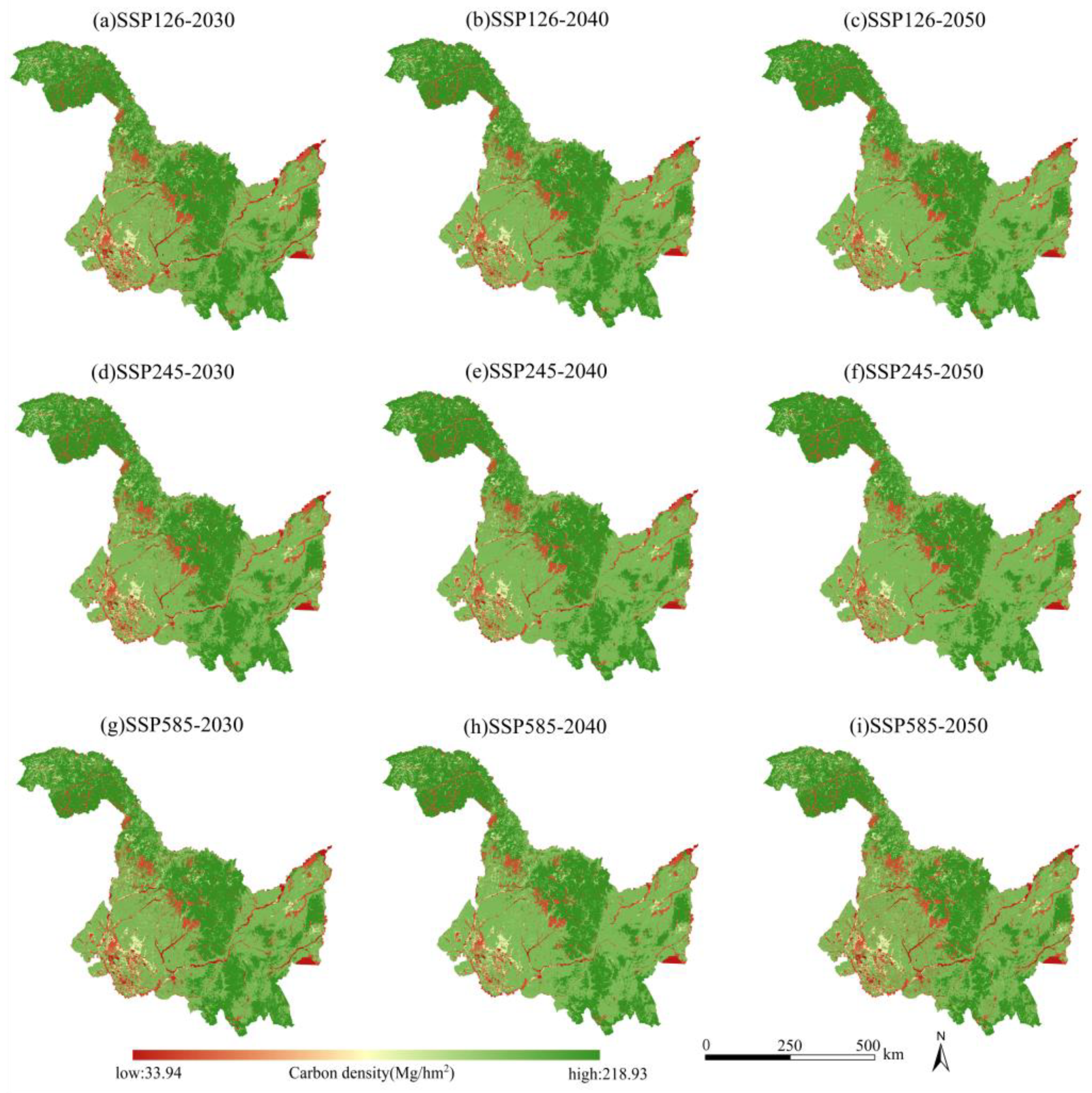


| Category | Data | Source | Year | Type |
|---|---|---|---|---|
| Land use/cover data | Land use/cover | Resource and Environmental Science Data Centre of the Chinese Academy of Sciences (https://www.resdc.cn/, accessed on 6 November 2022) | 2010, 2020 | raster (30 m) |
| SD model data | Gross Domestic Product | «Heilongjiang Statistical Yearbook» (http://tjj.hlj.gov.cn/, accessed on 6 November 2022) | 2000–2020 | numeric |
| Fixed Assets Investment | ||||
| Agricultural/Forestry/Livestock/Fishery production value | ||||
| Total/Rural/Urban population | ||||
| Urbanization rate | ||||
| PLUS driving factor data | Annual average temperature | Heilongjiang Provincial Meteorological Bureau (http://hlj.cma.gov.cn/, accessed on 8 November 2022) | 2000–2020 | raster (30 m) |
| Annual average precipitation | ||||
| GDP | Resource and Environmental Science Data Centre of the Chinese Academy of Sciences (https://www.resdc.cn/, accessed on 6 November 2022) | 2015 | raster (1 km) | |
| Population density | ||||
| Soil type | Harmonized World Soil Database (HWSD)v 1.2 (http://westdc.westgis.ac.cn/, accessed on 6 November 2022) | 2008 | raster (1 km) | |
| DEM | Geospatial Data Cloud platform (http://www.gscloud.cn/, accessed on 8 November 2022) | 2020 | raster (30 m) | |
| Slope | ||||
| Distance to river | National Geomatics Center of China (http://www.ngcc.cn/ngcc/, accessed on 10 November 2022) | 2015 | Vector | |
| Distance to road | Open Street Map (https://www.openstreetmap.org/, accessed on 10 November 2022) |
| Parameter Type | 2020–2030 | 2030–2040 | 2040–2050 | ||||||
|---|---|---|---|---|---|---|---|---|---|
| SSP126 | SSP245 | SSP585 | SSP126 | SSP245 | SSP585 | SSP126 | SSP245 | SSP585 | |
| GGR (%) | 6.400% | 5.000% | 7.500% | 3.900% | 2.500% | 4.800% | 1.900% | 1.400% | 2.500% |
| PGR (%) | 2.770% | 4.420% | 3.560% | −0.640% | 1.950% | 0.450% | −2.550% | 1.240% | −1.030% |
| PC (mm) | 2.800 | 3.200 | 4.000 | 2.800 | 3.200 | 4.000 | 2.800 | 3.200 | 4.000 |
| TC (°C) | 0.006 | 0.026 | 0.059 | 0.006 | 0.026 | 0.059 | 0.006 | 0.026 | 0.059 |
| Land Use Type | Farmland | Woodland | Grassland | Water | Construction Land | Unused Land |
|---|---|---|---|---|---|---|
| Weight | 0.068 | 0.012 | 0.022 | 0.481 | 0.389 | 0.028 |
| Land Use Type | C_Above | C_Below | C_Soil | C_Dead |
|---|---|---|---|---|
| Farmland | 10.10 | 26.80 | 147.00 | 0.00 |
| Woodland | 11.46 | 31.32 | 173.90 | 2.25 |
| Grassland | 7.96 | 51.00 | 74.60 | 2.84 |
| Water | 8.72 | 2.21 | 23.01 | 0.00 |
| Construction land | 8.75 | 4.39 | 27.78 | 1.16 |
| Unused land | 10.03 | 0.00 | 44.79 | 0.00 |
| Land Use Type | Actual Value in 2020 (hm2 × 104) | Predicted Value in 2020 (hm2 × 104) | Simulation Error (%) |
|---|---|---|---|
| Farmland | 1747.91 | 1778.57 | −1.75 |
| Woodland | 1918.51 | 1728.26 | 9.92 |
| Grassland | 220.05 | 231.83 | −5.35 |
| Water | 102.18 | 125.77 | −23.09 |
| Construction land | 106.53 | 113.65 | −6.68 |
| Unused land | 429.45 | 445.74 | −3.79 |
| Land Use Type | Actual Value in 2020 (hm2 × 104) | Predicted Value in 2020 (hm2 × 104) | Simulation Error (%) |
|---|---|---|---|
| Farmland | 1747.91 | 1725.79 | 1.27 |
| Woodland | 1918.51 | 1907.56 | 0.57 |
| Grassland | 220.05 | 224.65 | −2.09 |
| Water | 102.18 | 116.18 | −13.71 |
| Construction land | 106.53 | 107.26 | −0.69 |
| Unused land | 429.45 | 421.16 | 1.93 |
Disclaimer/Publisher’s Note: The statements, opinions and data contained in all publications are solely those of the individual author(s) and contributor(s) and not of MDPI and/or the editor(s). MDPI and/or the editor(s) disclaim responsibility for any injury to people or property resulting from any ideas, methods, instructions or products referred to in the content. |
© 2023 by the authors. Licensee MDPI, Basel, Switzerland. This article is an open access article distributed under the terms and conditions of the Creative Commons Attribution (CC BY) license (https://creativecommons.org/licenses/by/4.0/).
Share and Cite
Gao, F.; Xin, X.; Song, J.; Li, X.; Zhang, L.; Zhang, Y.; Liu, J. Simulation of LUCC Dynamics and Estimation of Carbon Stock under Different SSP-RCP Scenarios in Heilongjiang Province. Land 2023, 12, 1665. https://doi.org/10.3390/land12091665
Gao F, Xin X, Song J, Li X, Zhang L, Zhang Y, Liu J. Simulation of LUCC Dynamics and Estimation of Carbon Stock under Different SSP-RCP Scenarios in Heilongjiang Province. Land. 2023; 12(9):1665. https://doi.org/10.3390/land12091665
Chicago/Turabian StyleGao, Fengjie, Xiaohui Xin, Jianxiang Song, Xuewen Li, Lin Zhang, Ying Zhang, and Jiafu Liu. 2023. "Simulation of LUCC Dynamics and Estimation of Carbon Stock under Different SSP-RCP Scenarios in Heilongjiang Province" Land 12, no. 9: 1665. https://doi.org/10.3390/land12091665
APA StyleGao, F., Xin, X., Song, J., Li, X., Zhang, L., Zhang, Y., & Liu, J. (2023). Simulation of LUCC Dynamics and Estimation of Carbon Stock under Different SSP-RCP Scenarios in Heilongjiang Province. Land, 12(9), 1665. https://doi.org/10.3390/land12091665






